How to report damp and mould
Let’s tackle damp and mould together
We understand how worrying damp and mould can be in your home.
Whether you're reporting a concern or looking for advice, we’re here to listen, support, and work with you to keep your home safe.
We’re here to help you understand what it is, why it happens, and what can be done.
Together, we can make your home safer, healthier, and more comfortable.
Complete the questionnaire in your account
What will happen? Our damp and mould team will review your report. Based on the severity, we’ll let you know our procedure and what the next steps will be.
My accountCall our Customer Experience Team
What will happen? Our team will complete a questionnaire with you regarding the damp and mould in your home. Based on the severity, we’ll let you know our procedure and what the next steps will be.
Call nowTell any Vico Homes colleague visiting your home
What will happen? A colleague may take photos of the damp and mould. They might complete a questionnaire with you at your home and report this back to our team.
What is damp, mould and condensation?
Condensation is caused when warm moist air hits a cold surface such as a window or external wall.
Damp is the excess moisture in your home, and mould is what can grow if it’s not dealt with.
It’s not always easy to spot, but we’ll guide you through it step-by-step, with clear advice and support.
You can find more information in our Healthy Homes guide below.
You can also find advice in our FAQs further down this page and we've put together a quick quiz to help you understand when you need to report an issue to us.
Causes of damp, mould and condensation
Find out more about what causes damp, mould and condensation on our handy web page. You can also find plenty of tips and tricks for preventing all three!
Find out moreA guide to beating condensation
Visit our condensation busting web page to find out how you can beat damp and mould at source. We've got top tips, quizzes and guides to help you find the best way to keep your home warm and dry.
Find out moreTake our quiz to see when you should make a report to us.
Condensation happens when warm, moist air meets a cold surface, like windows or walls. Everyday activities like cooking, showering, and even breathing release moisture into the air.
No. Condensation is the most common form of moisture in homes and can lead to mould if unmanaged. Damp includes rising damp (from the ground) and penetrating damp (from leaks).
Look for tide marks, blistering paint, peeling wallpaper, and salt deposits up to a metre high on walls. Rising damp usually starts from the ground up.
Penetrating damp is caused by water from external defects like leaking roofs, walls, or pipes. It can look similar to condensation or rising damp.
Mould can trigger respiratory issues, allergies, and make conditions like asthma worse. It's especially harmful to vulnerable people, such as children, the elderly, and those with weakened immune systems.
There are a few ways you can help to reduce risk of damp, mould, and condensation in your home, including:
- Use extractor fans when cooking or showering.
- Dry clothes outdoors or in well-ventilated rooms.
- Maintain a consistent temperature.
- Wipe down windows and cold surfaces daily.
- Opening windows to ensure rooms are ventilated.
Small patches of mould can be cleaned using mould remover or diluted bleach. Wear gloves and ventilate the area.
For issues that keep coming back or cover a bigger area, please contact us for support immediately.
Yes - placing furniture directly against walls can restrict airflow and encourage mould. Leaving gaps to allow air to circulate could help.
Report it to us immediately on 0345 8 507 507. Provide as much detail as possible, and we’ll assess the issue, give you advice, or may contact you to arrange a surveyor visit.
Yes. Colder months (typically September to March) increase the risk of condensation because temperatures are lower and we might open our windows to ventilate rooms less often.
Simple actions like ventilating rooms by opening windows or using extractor fans, heating consistently, and wiping down surfaces can make a big difference in preventing damp or mould.
Yes. If the issue is structural or caused by external factors, our surveyors will assess the problem, and we’ll do any necessary repairs.
We only ask that you are responsible for prevention, which includes wiping down windows and damp surfaces whenever you notice moisture.
Disrepair claims – let’s talk before you decide
We know that some companies may reach out to you, encouraging you to make housing disrepair claims.
They might offer quick wins or promise compensation but they don’t always explain the full picture. Some of these companies charge hidden fees, tie people into contracts, or give advice that could put your tenancy at risk, especially if it involves refusing access for repairs.
That’s why it’s so important to understand your options before taking any steps. We’re here to help you look after your home.
If you’re ever approached about making a claim, please come and speak to us first. We’ll always be honest with you, explain what’s happening, and work with you to get things sorted.
Your home matters to us, and so do you.



